The livestock sector is currently the main user of land resources, accounting for around 30% of the world’s land area(1). The competition for plant products between our food intake requirements and those of livestock will increase as the human population grows, and health recommendations for a more plant-based diet are likely to accentuate this demand. How will the allocation of farmland be decided in future, and how will the need for animal by-products, from ruminants (cattle, sheep) and monogastric animals (poultry) for pet food be met?
In the United States, for example, conventional meat-based pet foods use more than a quarter of all animal calories in the United States, where dogs and cats consume 30% of all meat from intensively farmed animals(2). In view of the environmental impact of meat diets, we need to consider a portfolio of new sources of high-quality protein, such as insects and yeast, and ensure that they are available worldwide.
Increasing numbers of dogs and cats
Just like the human population, the dog and cat populations are continuing to grow. With over 110 billion dogs and cats, China already has the largest number of pets in the world, recently surpassing the United States(3). In Europe, the pet population increased by 22% by 2022, with 127 million cats and 104 million dogs(4).
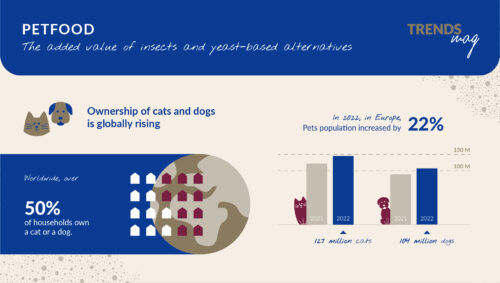
The growing rate of pet ownership is driving demand in the dog and cat food market, but also in the supplements market, which is now looking for innovation. In industrialised countries, the increasing humanisation of pets and concerns about their health are generating demand for a premium range of dry and wet foods incorporating higher quality proteins with greater biological value. At the same time, a range of supplements focusing on digestive, skin, coat, hip and joint health is developing. In terms of revenue, the global pet supplements market was valued at around $1.91 billion in 2022 and is expected to reach $3.12 billion by 2030 at a CAGR of around 5.91% during the forecast period(5) (2022-2030).
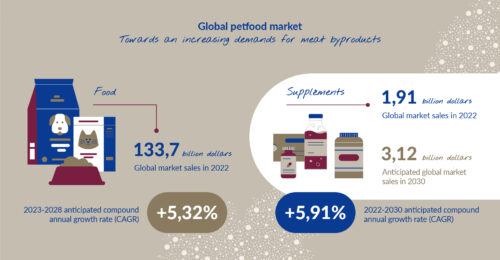
Given the annual revenue from these 2 particularly dynamic markets, new players, regional companies and start-ups are seeking to win over owners looking for balanced foods adapted to each stage of their pet’s life, that are both ethical and eco-friendly. Two key characteristics for the coming decades…
Varying protein sources
As all dog and cat owners know, protein is an essential macronutrient in their pet’s diet, with requirements varying according to the animal’s age, activity, state of health and reproductive status. The source of the protein is not as important as the amino acids it provides for the animal. So as well as the quantity, you need to pay attention to the quality of the proteins and their digestibility. For dogs, a quality protein will include at least the 10 essential amino acids and 11 for cats (with taurine being essential). Where can we find new sources of protein?
Edible insects and yeast are a good source of essential nutrients, particularly amino acids, as well as minerals and vitamins. Insects are also high in fatty acids. Insect- and yeast-derived ingredients are environmentally sustainable, highly digestible and could also benefit pet health. They also have the advantage of obtaining positive results in palatability tests.
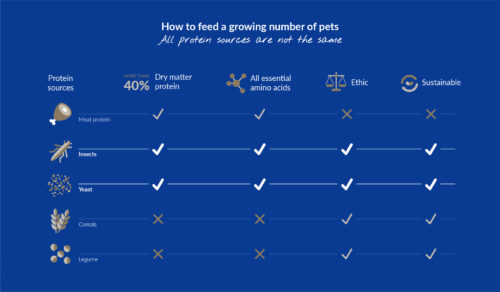
Insect-based pet food is a relatively new concept in the market. The successful launch of such a unique product depends heavily on the appropriate marketing of functional claims(5). The perception of health and sustainability claims by pet owners will be one of the key drivers fuelling the growth of the insect-based pet food industry(6).
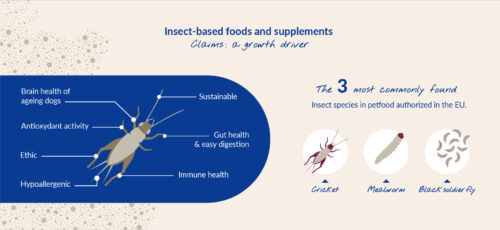
It is worth remembering that insects are also a source of food in the natural environment of canids of various species, such as the short-eared dog (Atelocynus microtis), the bat-eared fox (Otocyon megalotis) and the Rüppell’s fox (Vulpes rueppellii). Insects can also account for up to 6% of the diet of wild cat species(7).
Little by little, insects are becoming more acceptable. 83% of dog and cat owners in the United States say they are prepared to feed their pets insect-based ingredients.
Yeast and yeast derivatives, a source of bioactive components
Animals have been fed various forms of yeast and yeast derivatives for over 100 years Considerable research has been carried out to assess the potential growth performance of animals and the health benefits of adding yeast, yeast derivatives and yeast-containing ingredients to animal food(8).
Many dog and cat foods contain a yeast ingredient, most often dried brewer’s yeast, but also yeast extract, yeast cell walls, selenium-enriched yeast or active yeast. As described below, yeast is an excellent source of bioactive components. Dog and cat owners are well aware of the remarkable palatability of nutritional yeast and its benefits for skin and coat health. But yeast has many other benefits that deserve to be publicised as widely as possible!
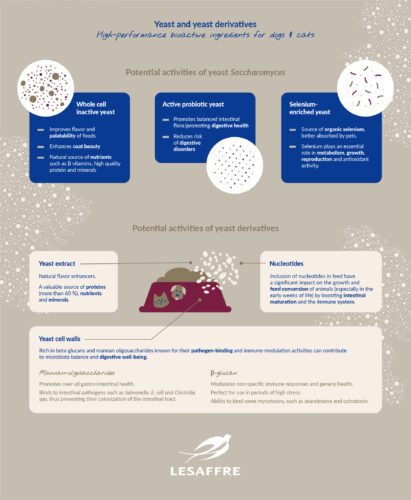
Given their nutritional and functional benefits, yeast and insects clearly offer alternative and even complementary proteins in the formulation of food and health supplements for our pet friends.
And did you know that yeast is even good for insects? Trials carried out at Wageningen University in the Netherlands (2019), showed that a probiotic yeast reference Actisaf Sc47 developed by Phileo contributed to better zootechnical performance of the yellow mealworm and the black soldier fly(9). Providing feedstuffs and supplements for farmed insects has a major influence on the nutritional composition of insect meal (proteins, unsaturated fatty acids), making it competitive with other protein sources.
There’s no doubt that yeast and insects have great potential when it comes to producing healthy, sustainable animal feed.
bibliographical references:
-
FAO – HLPE Rapport #10 (2016)
-
Pim Martens & al.,The Ecological Paw Print of Companion Dogs and Cats - BioScience, Vol. 69, Issue 6, pp 467–474 (2019)
-
Association chinoise de l’industrie des animaux de compagnie
-
FEDIAF – Facts & Figures 2021-2022 et Statista Market Insights (Marché mondial des aliments pour animaux de compagnie 2022-2030)
-
Fact s & Factors – Pet supplement market size (2023-2030)
-
Siddiqui & al., Insect-based dog and cat food: A short investigative review on market, claims and consumer perception – Journal of Asia-Pacific Entomology, vol.26, Issue 1 (2023)
-
Kępińska-Pacelik &al., Insects in pet food industry – Hope or Threat?, Animal Basel, 12(12): 1515 (2022)
-
G.C. Shurson, Yeast and yeast derivatives in feed additives and ingredients: sources, characteristics, animal responses and quantification methods– Animal Feed Science & Technology, vol.235, pp 60-76 (2018)
-
Richard & all, Poster Live yeast probiotic can boost growth performance of yellow meal worm and black soldier fly larvae, Insectinov3 (2019)
Sources Potential activities of yeast and yeast derivatives
-
Swanson & al., Potential role of yeast and yeast by-products in pet foods- Recent Advances in Pet Nutrition (2006)
-
Beynen AC, Yeast in petfood (2019)
-
Beynen AC. MOS in dog food (2019)
-
Beynen AC. Beta-glucans in dog food (2019)
-
Stercova E, Kumprechtova D, Auclair E, Novakova J. Effects of live yeast dietary supplementationon nutrient digestibility and fecal microflora in beagle dogs. J Anim Sci ; 94: 2909-2918 (2016)
-
Russo & al., Nucleotide inclusion in pet food: effect of heat treatment and storage – Journal of nutritionand internal medicine, vol.21 n°4 (2019)
-
Reilly & al., Use of Legumes and Yeast as Novel Dietary Protein Sources in Extruded Canine Diets – Front. Vet. Sci., 04 June 2021 Sec. Animal Nutrition and Metabolism Volume 8 (2021)
-
Bastos & al., Effect of Yeast Saccharomyces cerevisiae as a Probiotic on Diet – Digestibility, Fermentative Metabolites, and Composition and Functional Potential of the Fecal Microbiota of Dogs Submitted to an Abrupt Dietary Change – Microorganisms 2023, 11, 506


